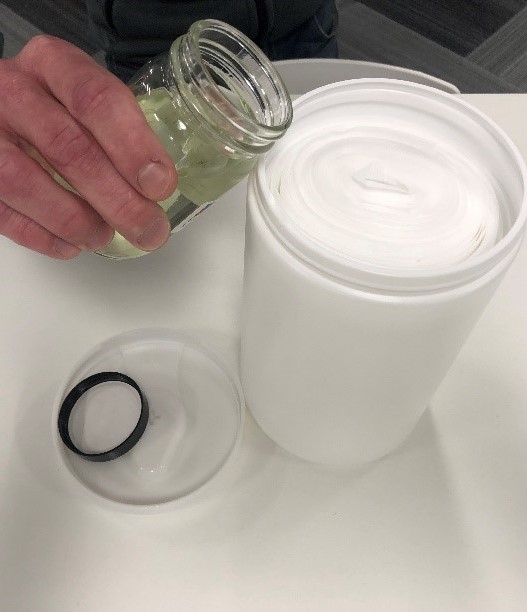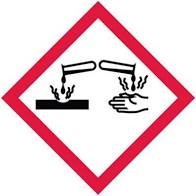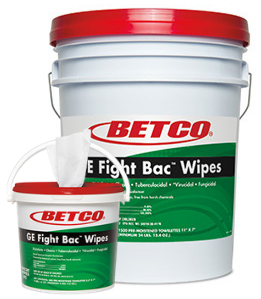
The COVID-19 pandemic created an explosion in demand for spray disinfectants and disinfectant wipes. While spray disinfectant supply has largely recovered—and contrary to the natural conclusion of Betco® having just launched GE Fight Bac™ Wipes in Big Bucket and Little Bucket formats—the disinfectant wipe shortage lingers on in the market as a
whole. This combination of factors has inspired countless attempts by distributors, facility end users, and consumers to make DIY (do it yourself) disinfectant wipes.
Unbeknownst to many who make and use them, DIY disinfectant wipes may actually increase the risk of infection, jeopardize user health and safety, and violate federal law.
1. Legal Concerns
- As covered in a previous blog post, any disinfectant
or disinfectant wipe sold or distributed in the United States must be registered with the EPA. Even if the liquid disinfectant itself is registered, a disinfectant wipe product made using that liquid disinfectant requires a unique EPA registration number.
For example, liquid GE Fight Bac RTU’s EPA registration number is 34810-35-4170, while GE Fight Bac Wipes have an EPA registration number of 34810-36-4170.
- Only EPA-registered disinfectant wipes produced in an EPA-registered facility—such as Betco—can make any kill claims. DIY disinfectant wipes cannot legally claim to kill any viruses, bacteria, mold, or fungi,
because:
- The EPA has not reviewed or approved their efficacy data, as is required during the registration process.
- Distributor warehouses and end user back rooms are not EPA-registered facilities.
- As stated by EPA regulations and on the label of every single legal disinfectant, “it is a violation of Federal Law to use this product in a manner inconsistent with its labeling.” If pre-saturated wipes are not listed explicitly on
the label as an approved use for the product, making DIY disinfectant wipes with that product is illegal.
- Legally, all disinfectants and disinfectant wipes must bear an EPA-approved label and, if used in the workplace, be accompanied by a Safety Data Sheet (SDS). DIY wipes, by nature, do not tick either of these required boxes, especially as the labels and SDSs for liquid disinfectants are not transferrable to wipes made from them.
2. Health and Safety of Users
 All
EPA-registered products have been tested for toxicity, irritation, and sensitization hazards, and—based on a series of required standardized tests—carry appropriate precautionary statements and Personal Protective Equipment (PPE)
recommendations on the label. As DIY disinfectant wipes utilize liquid disinfectants that have not had their safety tested or approved for use in this manner, and also because (as stated in #1) SDSs and labels for a liquid
disinfectant do not apply to pre-soaked wipes, users of DIY wipes:
All
EPA-registered products have been tested for toxicity, irritation, and sensitization hazards, and—based on a series of required standardized tests—carry appropriate precautionary statements and Personal Protective Equipment (PPE)
recommendations on the label. As DIY disinfectant wipes utilize liquid disinfectants that have not had their safety tested or approved for use in this manner, and also because (as stated in #1) SDSs and labels for a liquid
disinfectant do not apply to pre-soaked wipes, users of DIY wipes:
- Have no way of learning:
- Safe handling.
- Proper use, including required PPE.
- First aid measures.
- Exposure controls.
- Toxicological information.
- Proper storage and disposal.
- Are vulnerable to risks associated with uneducated use of many types of disinfectants, including:
- Skin corrosion.
- Toxic vapors.
- Serious eye damage.
- Increased incidence of cancer.
- Organ damage.
3. Efficacy and Stability

- Efficacy testing methods required for EPA registration of disinfectant wipes are different than spray products. For example, efficacy with the specific wipe material must be tested and documented. This is important because certain materials may absorb the disinfectant solution differently, inhibiting release on surfaces and providing inadequate disinfection.
- Quat-based disinfectants lose their efficacy when used with pulp/cellulose wipes due to quat binding. As a result, the level of disinfection may not be adequate to meet the disinfection rating of the product.
- The amount of liquid in disinfectant wipe containers are specified through the EPA registration process. DIY wipes require estimation of solution, often resulting in:
- Premature drying out of wipes and mold growth inside the canister (pictured right) if too little liquid is used.
- Oversaturation, which causes wipes to degrade, if too much liquid is used.
- Because the EPA has not reviewed or approved efficacy data for DIY disinfectant wipes (as stated in #1), the wipes cannot carry a single kill claim against any viruses, bacteria, mold, or fungi, which begs the question…why
use them?
We understand that it is still difficult to find disinfectant wipes but posit that making or using DIY disinfectant wipes simply isn’t worth the risk. If EPA-registered wipes cannot be procured, the best course of action is to use a spray disinfectant
as directed on the label.
 you are having trouble procuring disinfectant wipes, Betco may be able to help. Our new GE Fight Bac Wipes feature the EPA List N benefits of GE Fight Bac RTU in a convenient wipe.
you are having trouble procuring disinfectant wipes, Betco may be able to help. Our new GE Fight Bac Wipes feature the EPA List N benefits of GE Fight Bac RTU in a convenient wipe.
- Kill 99.9% of bacteria and viruses in 5-minute contact time.
- No need for safety signal words like “Danger” or “Warning” on the label, easing the minds of users.
- In EPA’s lowest toxicity category (category IV) and certified by Green Earth standards.
- No PPE required thanks to non-irritating ingredients with no harsh fumes.
Please click here and fill out the online form to request ordering information.